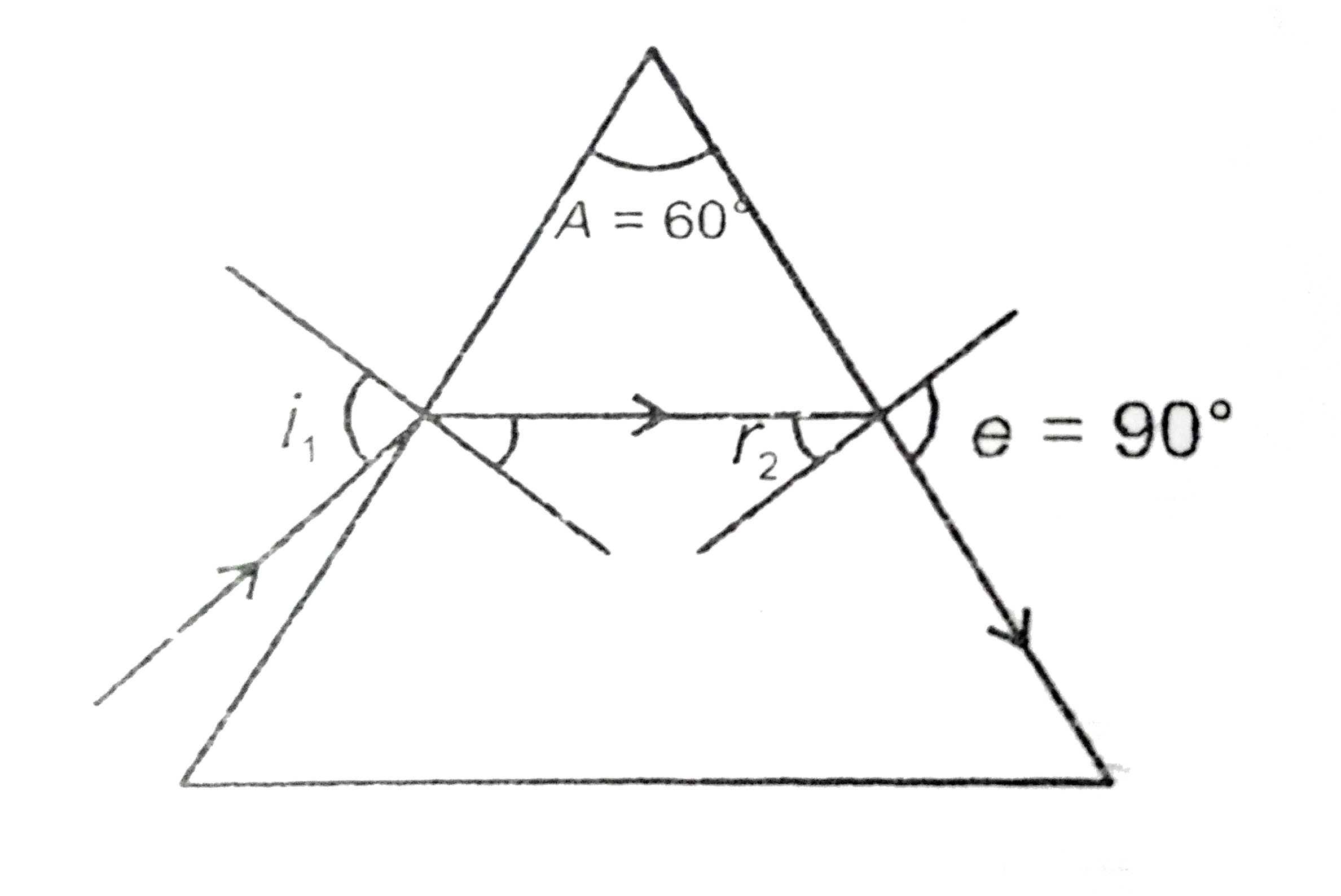Light travelling in air falls at an incidence angle of 2∘ on one rafracting surface of a prism of refractive index 1.5 and angle of refraction 4∘. The medium on the other side is water (n=4/3) . Find the deviation produced by the prism.
The correct Answer is:1∘
To find the deviation produced by the prism, we will follow these steps:
Step 1: Understand the Problem
We have light traveling from air into a prism and then into water. The refractive indices are given as follows:
- Refractive index of air, n1=1
- Refractive index of prism, n=1.5
- Refractive index of water, n2=43
The angle of incidence i=2∘ and the angle of refraction r1=4∘ when the light enters the prism.
Step 2: Apply Snell's Law at the First Surface
Using Snell's Law at the first surface (air to prism):
n1sin(i)=nsin(r1)
Substituting the known values:
1⋅sin(2∘)=1.5⋅sin(4∘)
Step 3: Calculate Angle of Refraction r1
Using the small angle approximation (since angles are small):
sin(2∘)≈2π180⋅2≈0.0349andsin(4∘)≈2π180⋅4≈0.06976
Now substituting:
0.0349=1.5⋅0.06976
This confirms that r1 is indeed 4∘.
Step 4: Find Angle of Refraction r2
The angle of the prism A is given as:
A=r1+r2
Given that the angle of the prism is 4∘:
4∘=r1+r2
Substituting r1=4∘:
r2=4∘−r1=4∘−43∘=83∘
Step 5: Apply Snell's Law at the Second Surface
Using Snell's Law at the second surface (prism to water):
nsin(r2)=n2sin(e)
Substituting the known values:
1.5⋅sin(83∘)=43⋅sin(e)
Step 6: Calculate Angle of Emergence e
Using the small angle approximation again:
sin(83∘)≈8π3⋅180≈0.0461
Now substituting:
1.5⋅0.0461=43⋅sin(e)
Solving for sin(e):
sin(e)=1.5⋅0.0461⋅34≈0.0173
Thus, e≈3∘.
Step 7: Calculate the Angle of Deviation δ
Using the formula for deviation:
δ=i+e−A
Substituting the values:
δ=2∘+3∘−4∘=1∘
Final Answer
The deviation produced by the prism is δ=1∘.
We have light traveling from air into a prism and then into water. The refractive indices are given as follows:
- Refractive index of air, n1=1
- Refractive index of prism, n=1.5
- Refractive index of water, n2=43
Using Snell's Law at the first surface (air to prism):
n1sin(i)=nsin(r1)
Substituting the known values:
1⋅sin(2∘)=1.5⋅sin(4∘)
Using the small angle approximation (since angles are small):
sin(2∘)≈2π180⋅2≈0.0349andsin(4∘)≈2π180⋅4≈0.06976
Now substituting:
0.0349=1.5⋅0.06976
This confirms that r1 is indeed 4∘.
The angle of the prism A is given as:
A=r1+r2
Given that the angle of the prism is 4∘:
4∘=r1+r2
Substituting r1=4∘:
r2=4∘−r1=4∘−43∘=83∘
Using Snell's Law at the second surface (prism to water):
nsin(r2)=n2sin(e)
Substituting the known values:
1.5⋅sin(83∘)=43⋅sin(e)
Using the small angle approximation again:
sin(83∘)≈8π3⋅180≈0.0461
Now substituting:
1.5⋅0.0461=43⋅sin(e)
Solving for sin(e):
sin(e)=1.5⋅0.0461⋅34≈0.0173
Thus, e≈3∘.
Using the formula for deviation:
δ=i+e−A
Substituting the values:
δ=2∘+3∘−4∘=1∘
The deviation produced by the prism is δ=1∘.
Topper's Solved these Questions
- GEOMATRICAL OPTICS Book:RESONANCE ENGLISHChapter:GEOMATRICAL OPTICS Exercise:Exercise-3
Explore 80 Videos
- EXPERIMENTAL PHYSICSBook:RESONANCE ENGLISHChapter:EXPERIMENTAL PHYSICSExercise:PART -II
Explore 10 Videos
- GRAVITATIONBook:RESONANCE ENGLISHChapter:GRAVITATIONExercise:HIGH LEVEL PROBLEMS
Explore 16 Videos
Similar Questions
When a ray of light is incident normally on one refracting surface of an equilateral prism (Refractive index of the material of the prism =1.5
View SolutionThere is prism of refractive index 1.5 and prism angle 2degree. Find minimum deviation caused by this prism
View SolutionA prism of refracting angle 4∘ is made of a material of refractive index 1.652. Find its angle of minimum deviation.
View SolutionWhen a ray of light is incident normally on one refracting surface of an equilateral prism (Refractive index of the material of the prism =1.5)
View SolutionA ray of light is incident normally on one face of an equilateral prism of refractive index 1.5. The angle of deviation is: (Given sin−1.23=42∘)
View SolutionFor a prism of refractive index 1.732, the angle of minimum deviation is equal to the angle of the prism. The angle of the prism is
View SolutionLight falls at normal incidence on one face of a glass prism of refractive index 1.5, what will be the angle of emergence when the angle of the prism is (a) 30∘ (b) 50∘ ?
View SolutionThe refracting angle of a prism is A, and refractive index of the material of the prism is cot(A2). The angle of minimum deviation is
View SolutionA ray of light is incident normally on one of the faces of a prism of apex angle 30 degree and refractive index √2. The angle of deviation of the ray in degrees is
View SolutionCalculate the angle of incidence on the face of a prism of refracting angle 60∘ and of refractive index 1.5, for which the emergent ray just grazes the other face.

View Solution
